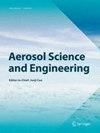Risk Assessment and Source Analysis of Atmospheric Heavy Metals Exposure in Spring of Tianjin, China
Abstract
With the rapid development of the social economy and the frequent occurrence of haze, heavy metals in atmospheric particulates have been shown harmful to human health. In this paper, the samples of atmospheric particulate matter (PM10 and PM2.5) were collected in two typical sites of Tianjin in spring. The concentration of 6 heavy metals in PM10 and PM2.5 were analyzed by microwave digestion inductively coupled plasma mass spectrometry method. The enrichment factor (EF) method was used to identify the sources of heavy metals in particulate matter. The results showed that the daily average concentrations of PM10 and PM2.5 in Tianjin were notably influenced by building construction, traffic-related emission and meteorological condition. The heavy metals in the atmospheric particulate matter were as follows: ρ(Mn) > ρ(Pb) > ρ(Ni) > ρ(V) > ρ(Cd) > ρ(Co) and more easily enriched in fine particles PM2.5. The result of EF analysis suggested that the V, Mn, Co and Ni were not enriched, and the source of them in the atmospheric particulate matter samples was mainly nature. Cd and Pb were typical pollution elements in spring of Tianjin, and predominantly derived from human activities. Health risk assessment demonstrated that the carcinogenic risk levels of heavy metals in the atmospheric particulate matter samples were generally followed the order of men > women > children. Cd and Pb in the atmospheric particulate matter had no carcinogenesis risk. The potential carcinogenic risk of Ni was evaluated as acceptable and tolerable. This study could provide a scientific reference for the prevention and control of atmospheric particulate pollution.

 求助内容:
求助内容: 应助结果提醒方式:
应助结果提醒方式:


